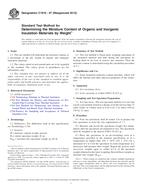Potřebujeme váš souhlas k využití jednotlivých dat, aby se vám mimo jiné mohly ukazovat informace týkající se vašich zájmů. Souhlas udělíte kliknutím na tlačítko „OK“.
ASTM D3755-14
Standard Test Method for Dielectric Breakdown Voltage and Dielectric Strength of Solid Electrical Insulating Materials Under Direct-Voltage Stress
Automaticky přeložený název:
Standardní zkušební metoda pro Dielektrická napětí a dielektrickou pevnost těles elektrických izolačních materiálů pod přímým napětí stresu
NORMA vydána dne 15.5.2014
Informace o normě:
Označení normy: ASTM D3755-14
Poznámka: NEPLATNÁ
Datum vydání normy: 15.5.2014
Kód zboží: NS-24736
Počet stran: 6
Přibližná hmotnost: 18 g (0.04 liber)
Země: Americká technická norma
Kategorie: Technické normy ASTM
Kategorie - podobné normy:
Anotace textu normy ASTM D3755-14 :
Keywords:
conditioning, creepage, criteria of breakdown, dielectric breakdown voltage, dielectric strength, direct voltage, direct voltage stress, electrodes, flashover, rupture, solid insulating materials, surrounding medium, voltage control, voltmeter, ICS Number Code 29.035.01 (Insulating materials in general)
Doplňující informace
| Significance and Use | ||||||||||||||
|
5.1 This test method is intended for use as a control and acceptance test for direct-voltage applications. It can also be used in the partial evaluation of material for specific end uses and as a means for detecting changes in material due to specific deteriorating causes. 5.2 Experience indicates that the breakdown value obtained with direct voltage usually will be approximately 2 to 4 times the rms value of the 60-Hz alternating-voltage breakdown. 5.3 For a nonhomogeneous test specimen, the distribution of voltage stress within the specimen is determined by impedance (largely capacitive) with alternating voltage. With an increasing direct voltage, the voltage distribution will still be largely capacitive, although this depends partly on the rate of voltage increase. After steady application of direct voltage the voltage division across the test specimen is determined by resistance. The choice of direct or alternating voltage depends upon the purpose for which the breakdown test is to be used, and to some extent, on the intended application of the material. 5.4 A more complete discussion of the significance of dielectric breakdown tests is given in 1.1 This test method covers the determination of dielectric breakdown voltage and dielectric strength of solid electrical insulating materials under direct-voltage stress. 1.2 Since some materials require special treatment, reference shall also be made to ASTM specifications or to the test method directly applicable to the material to be tested. See Test Method D149 for the determination of dielectric strength of electrical insulating materials at commercial power frequencies. 1.3 This test method is similar to IEC Publication 243-2. All procedures in this test method are included in IEC 243-2. Differences between this test method and IEC 243-2 are largely editorial. 1.4 This standard does not
purport to address all of the safety concerns, if any, associated
with its use. It is the responsibility of the user of this standard
to establish appropriate safety and health practices and determine
the applicability of regulatory limitations prior to use.
Standard Test Method for Dielectric
Breakdown Voltage of Insulating Liquids Using Disk Electrodes Standard Test Methods for Solid Filling
and Treating Compounds Used for Electrical Insulation Standard Test Method for Dielectric
Breakdown Voltage and Dielectric Strength of Solid Electrical
Insulating Materials at Commercial Power Frequencies ANSI C68.1 Techniques for Dielectric Tests, IEEE
Standard No. 4. Standard Specification for Mineral
Insulating Oil Used in Electrical Apparatus (Includes all
amendments and changes 1/1/2018). D2436 Specification for Forced-Convection
Laboratory Ovens for Electrical Insulation Standard Terminology Relating to
Electrical Insulation |
Podobné normy:
Historická
1.9.2012
Historická
1.11.2013
Historická
1.4.2013
Historická
1.8.2011
Historická
1.5.2014
Historická
1.1.2012



 ASTM C1616-07(2012)..
ASTM C1616-07(2012).. ASTM C1785-13
ASTM C1785-13 ASTM D149-09(2013)..
ASTM D149-09(2013).. ASTM D150-11
ASTM D150-11 ASTM D1711-14
ASTM D1711-14 ASTM D2132-12
ASTM D2132-12
 Cookies
Cookies
